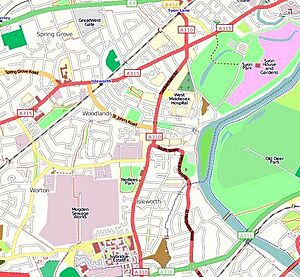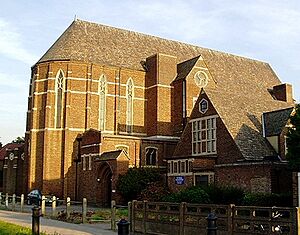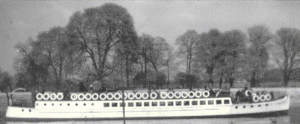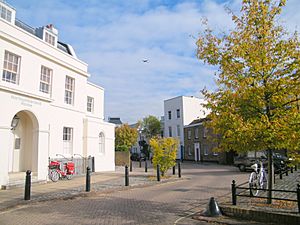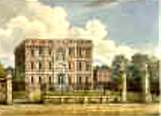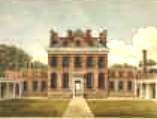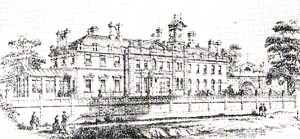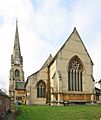Isleworth facts for kids
Isleworth (pronounced EYE-zəl-wərth) is a town in West London, England. It's part of the London Borough of Hounslow. You can find it just east of Hounslow town and west of the River Thames and its smaller river, the River Crane. The oldest part of Isleworth, right by the Thames, is called 'Old Isleworth'. The area to the north-west, near Osterley, is known as 'Spring Grove'.
Isleworth used to have a longer stretch of the River Thames, but in 1994, some of the riverside area was moved to the nearby district of St Margaret's. Now, most of Isleworth's riverfront looks out over a small island called Isleworth Ait. The River Crane flows into the Thames south of this island. Another man-made river, the Duke of Northumberland's River, also flows into the Thames west of the island.
Quick facts for kids Isleworth |
|
|---|---|
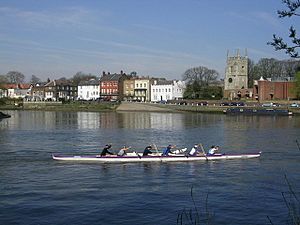 Church Street in Isleworth, seen from across the River Thames |
|
| Area | 8.31 km2 (3.21 sq mi) |
| Population | 25,008 (Isleworth, Osterley and Spring Grove wards 2011) |
| • Density | 3,009/km2 (7,790/sq mi) |
| OS grid reference | TQ1575 |
| Civil parish |
|
| London borough | |
| Ceremonial county | Greater London |
| Region | |
| Country | England |
| Sovereign state | United Kingdom |
| Post town | ISLEWORTH |
| Postcode district | TW7 |
| Dialling code | 020 |
| Police | Metropolitan |
| Fire | London |
| Ambulance | London |
| EU Parliament | London |
| UK Parliament |
|
| London Assembly |
|
Contents
- What's in a Name? The History of Isleworth's Name
- Isleworth's Past: A Look at History
- Isleworth's Location and Landscape
- Things to Do and See in Isleworth
- Learning in Isleworth: Schools and Colleges
- Churches in Isleworth
- Getting Around Isleworth: Transport
- Famous People from Isleworth
- Important Buildings: Landmarks
- People and Homes in Isleworth
- Nearby Towns and Areas
- Images for kids
- See also
What's in a Name? The History of Isleworth's Name
The name Isleworth has changed a lot over time! It comes from Old English, meaning 'Enclosure belonging to [a man called] Gīslhere'.
Here's how the name appeared in old records:
- 695: Gislheresuuyrth (in an Anglo-Saxon document)
- 1086: Gistelesworde (in the Domesday Book)
- 1301: Istelworth
- 1415: Ystelworth
- 1418: Thistelworth
- 1540: Istyllworth
- 1742: Isleworth (as seen on an engraving)
Isleworth's Past: A Look at History
Early Settlements: Roman and Anglo-Saxon Times
People have lived in Isleworth for a very long time! Digs near the Syon Park estate have found signs of a Roman-British settlement. The first time 'Gislheresuuyrth' was mentioned as a permanent home was in an Anglo-Saxon document from the year 695. The Domesday Book, a famous survey from 1086, says that Isleworth belonged to Earl Algar during the time of King Edward the Confessor (1042–1066). You can still find a road named after him today!
Norman Conquest and Feudal Lords
After the Normans conquered England in 1066, Isleworth was a valuable farming and trading area. It stretched from the River Thames all the way to Hounslow. The Domesday Book recorded it as 'Gistelesworde' with many farms and households, earning a lot of money for its feudal lords.
Later, Norman barons from the St Valeri family owned the manor (a large estate) of Isleworth. They didn't live there but used it to gain money and power.
Royal Ownership: The Duchy of Cornwall
In 1227, King Henry III took control of Isleworth and gave it to his brother, Richard, the First Earl of Cornwall. Richard built a new manor house with a tiled roof, chimney, and inner courtyard. It even had a watermill nearby. Sadly, this medieval manor house was burned down in 1264 during a war.
From Monastery to Dukes: Syon House and the Percy Family
In 1415, King Henry V gave land by the Thames to nuns from Sweden. They built their first monastery, Syon Monastery. In 1422, King Henry V gave ownership of Isleworth Manor to Syon Monastery. The nuns later chose a new spot within their manor to rebuild their monastery, which is where the famous Syon House stands today.
After 1539, King Henry VIII pulled down most of Syon Monastery. The land and manor were then given to Edward Seymour, the First Duke of Somerset, who built Syon House in 1548.
Later, in 1594, Queen Elizabeth I leased the manor of Syon to Henry Percy, the Ninth Earl of Northumberland. His family, now the Dukes of Northumberland, have owned it for over 400 years! The Royalist army even stayed there during the Battle of Brentford in 1642. Syon Park was later redesigned and landscaped by famous architects between 1766 and 1773.
Isleworth in Georgian and Victorian Times
In the 1700s, much of Isleworth became orchards, growing fruit. Then, in the 1800s, it turned into market gardens, supplying fresh produce to London. Some buildings from this time can still be seen in Lower Square and Church Street. Many grand mansions were built in Isleworth during this period for wealthy people. This happened because there were already royal homes and important buildings nearby, making the area very fashionable.
Isleworth in the 20th Century
The early 1900s saw a lot of new homes built in Isleworth, replacing many of the market gardens. Several new factories and offices also appeared, especially towards the north-east. This fast growth changed Isleworth from a farming area to a busy town in just 50 years.
Isleworth's Location and Landscape
Isleworth's land goes from 27 meters high in the north-west down to 4.9 meters by the River Thames. It's east of Hounslow, west of the River Thames, north of the River Crane, and south of the M4 motorway. The River Crane flows into the Thames, and the Duke of Northumberland's River also flows through the area.
Things to Do and See in Isleworth
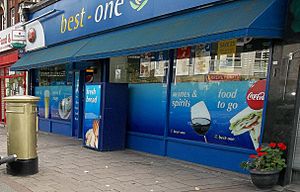
Isleworth is home to Isleworth Crown Court, a major court building. The town also has a public library, a leisure centre with a swimming pool and gym, four recreation grounds, and a town hall.
There used to be a film studio in Isleworth called Worton Hall Studios. A famous movie, The African Queen (1951), starring Humphrey Bogart, was filmed there! After the studio closed, it became a research center for coal mining and is now an industrial estate.
Sky, the satellite television company, has been based in Isleworth since 1989. Their large campus includes offices, studios, and even a wind turbine!
The Boat Cathja, a unique 38-meter barge, is moored in Old Isleworth. Since 1996, it has been home to a mental health charity that helps people use their artistic skills.
Hospitals in Isleworth
West Middlesex University Hospital This is a large hospital in Isleworth with many beds. It provides a full range of services and helps people from both Hounslow and Richmond. It's also a teaching hospital, linked with Imperial College London. The hospital has been modernized with new buildings and facilities.
Historic Hospitals
- Brentford Workhouse Infirmary and West Middlesex Hospital: This was originally a workhouse built in 1838. It became 'West Middlesex Hospital' in 1920 and later a university hospital. The old buildings were replaced with housing in 2003.
- Percy House Auxiliary Military Hospital: During World War I (1914–1918), a school building called Percy House was used as a military hospital. It treated about 5,000 wounded soldiers. The building was taken down in 1978.
- Mogden Isolation Hospital: An isolation hospital existed here for almost 100 years, opening in 1897. It was later renamed 'South Middlesex Fever Hospital' and then 'South Middlesex Hospital' before closing in 1991.
Learning in Isleworth: Schools and Colleges
West Thames College, a college for further education, is located in Isleworth.
Secondary Schools
- The Green School for Girls
- Gumley House Convent School (for girls)
- Isleworth and Syon School (for boys)
- The Green School for Boys
- Oaklands School (for students with special educational needs)
Primary Schools
- Ashton House School
- The Blue School (Church of England)
- Isleworth Town
- Ivybridge
- Marlborough
- Smallberry Green
- Spring Grove Primary
- St Mary's (Roman Catholic)
- Worple
Churches in Isleworth
All Saints' Church, Isleworth is the oldest church in the area. Other churches include:
- St Francis of Assisi Church
- St Bridget's RC Church
- St John's Church
- St Mary's Church
- St Mary the Virgin Church
- Isleworth Congregational Church
Getting Around Isleworth: Transport
Main Roads
The main road in Isleworth is the London Road (A315). This road generally follows an old Roman road. As it passes through different parts of London, it changes names, like Piccadilly, King Street, and High Street, before becoming London Road in Isleworth.
A larger road, the Great West Road (A4), was finished in 1925. It runs along the northern edge of Isleworth and helps traffic avoid the busy centers of Brentford and Hounslow. Another road, the Twickenham Road (A310), takes traffic towards Twickenham and Hampton Court.
Buses and Trams
Horse buses started running in Isleworth in the mid-1800s. Electric trams began in 1901 from a depot near the border with Hounslow. These trams were later replaced by trolleybuses in 1935. The 657 trolleybus route ran between Hounslow and Shepherd's Bush, passing through Isleworth. This trolleybus service ended in 1962.
Another trolleybus service, the 667, went from Hampton Court to Hammersmith, also passing through Isleworth. This was replaced by the 267 bus route.
A very old motor bus route, the number 37, also served Isleworth and Hounslow. It was one of the first motor bus routes in London and used to be very long, going all the way to Peckham. In 1991, this route was shortened, and the section through Isleworth became a new local service, the H37.
Trains
Isleworth has one train service, which is part of a loop line. This line runs off the main service between central London and Reading. It serves two stations in Isleworth: Syon Lane and Isleworth. Trains usually run every fifteen minutes.
Nearest National Rail stations
- Isleworth
- Syon Lane
Nearest London Underground stations
- Osterley (Piccadilly Line)
- Hounslow East (Piccadilly Line)
- Richmond (District Line)
River Passenger Services (History)
In the past, there were ferries across the River Thames from Isleworth. In 1840, there was Church Ferry, which took foot passengers from the church to West Sheen and Kew. Another ferry, Rails-head Ferry, was at the southern end of the village and was still in use in 1947.
Famous People from Isleworth
-
Vincent van Gogh, painted by himself ten years after residing in Isleworth
Many interesting people have lived in Isleworth:
- Peter Oliver (1594–1648), a miniature portrait artist, was born and lived in Isleworth. He painted portraits for King James I and King Charles I.
- In 1779, Sir Joseph Banks, a famous botanist, bought a house in Isleworth called "Spring Grove House." He created an amazing botanical garden there with many foreign plants he collected on his travels, including with Captain Cook to Australia.
- In 1804, J. M. W. Turner, a famous painter, lived in Sion Ferry House in Isleworth. He found inspiration for his paintings from the River Thames.
- Ian Gilmour, a politician, lived in the current Ferry House for 53 years until his death in 2007.
- The famous artist Vincent van Gogh lived in Isleworth in 1876, working as a teacher and assistant preacher. There's a blue plaque on the house where he lived.
- Andrew Pears, from the famous Pears soap business, bought Spring Grove House in 1886 and made it much larger. The house is now part of West Thames College.
- George Manville Fenn (1831-1909) was a writer who lived and is buried in Isleworth. He wrote many novels for young adults.
- Walter R. Booth (1869–1938), who made the first British animated cartoon film, built his own outdoor studio in Isleworth in 1906.
- Eileen Sheridan (1923–2023), a champion English cyclist, lived in Old Isleworth for many years.
- David Attenborough (1926–), the famous natural history presenter, was born in Isleworth. He's known for his amazing Life series with the BBC.
- William Hartnell, the first actor to play the First Doctor in Doctor Who, lived in Isleworth.
- Vince Taylor (1939–1991), a British rock and roll singer who inspired David Bowie's Ziggy Stardust, spent his early life in Isleworth.
- Presenter Fiona Phillips lives in Isleworth.
- Edd Gould (1988–2012), creator of the popular YouTube channel Eddsworld, lived in Isleworth.
- Dave Brock, founder of the band Hawkwind, was born in Isleworth.
- Ruel, an Australian singer-songwriter, was born in Isleworth.
Fictional Residents
- In the movie Gosford Park (2001), one of Sir William McCordle's factories was in Isleworth.
- In the TV series Agatha Christie's Poirot, Chief Inspector Japp is often mentioned as living in Isleworth.
Important Buildings: Landmarks
Notable Houses
Many grand mansions were built in Isleworth in the 1700s and 1800s. The area was very popular because of its beauty, riverside location, and the royal and noble homes already there.
- Syon House: This grand house has been connected to Isleworth for 450 years. It's a very important building and the main home of the Duke of Northumberland.
- Silver Hall No. 1: (Demolished 1801)
- Silver Hall No. 2: (Demolished 1950)
- Kendal House: Once home to the Duchess of Kendal, who was close to King George I.
- Somerset House
- Gunnersbury House: (Demolished around 1972)
- Isleworth House: Now called Nazareth House, it's a nursing home and convent.
- Countess of Charleville's Villa
- Wyke House
- Little Syon (formerly Cromwell House): (Demolished 1818)
- Gumley House: Owned by important figures like John Gumley and the Earl of Bath.
- Shrewsbury House: This house became a school for Roman Catholic boys around 1778.
- Gordon House: A beautiful house by the River Thames. It was once owned by King William IV for his daughter, Lady Augusta. It is currently being renovated.
- Spring Grove House: Owned by Sir Joseph Banks and later by Andrew Pears of Pears soap. It's now part of West Thames College.
- Keppel House: Home to Augustus Keppel, a First Lord of the Admiralty.
- Lacy House: A 17th-century house rebuilt in 1750. It was later owned by the famous playwright Richard Sheridan. (Demolished in the 1830s)
- St Margaret's House: Built after Lacy House was rebuilt.
- Kilmorey House: Built in 1853, it became the Royal Naval School for Girls. (Demolished 1950)
People and Homes in Isleworth
In the 2011 Census, about half of the people in Isleworth were White British. Other groups included people from other White backgrounds, Black Africans, Indians, and other Asians.
Most people (63.3%) living in Isleworth were born in England. Other common birthplaces included India, Somalia, Ireland, and Pakistan.
The main religions in Isleworth are Christianity, Islam, Hinduism, and Sikhism. Many people also reported having no religion.
Here's a quick look at homes in Isleworth from the 2011 Census:
| Ward | Detached | Semi-detached | Terraced | Flats and apartments | Caravans/temporary/mobile homes/houseboats | Shared between households |
|---|---|---|---|---|---|---|
| Isleworth | 124 | 880 | 1,416 | 2,451 | 4 | 18 |
| Osterley and Spring Grove | 420 | 1,900 | 467 | 1,981 | 4 | 24 |
And here's about households:
| Ward | Population | Households | % Owned outright | % Owned with a loan | hectares |
|---|---|---|---|---|---|
| Isleworth | 11,977 | 4,893 | 15 | 30 | 197 |
| Osterley and Spring Grove | 13,031 | 4,796 | 29 | 33 | 634 |
Nearby Towns and Areas
 |
Heston, Marylebone | Osterley | North Brentford, Brentford |  |
| Hounslow | Brentford Kew |
|||
| Twickenham Whitton |
Twickenham St. Margarets |
Richmond |
Images for kids
See also
 In Spanish: Isleworth para niños
In Spanish: Isleworth para niños



